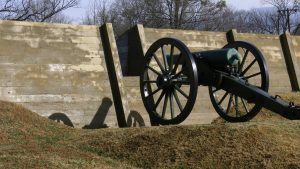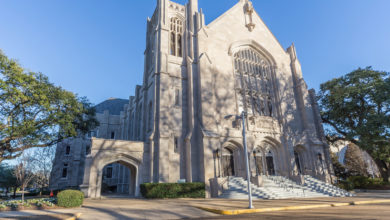Explore Mississippi’s Civil War Past
Travel back into time to see the relics of the "War Between the States"

Mississippi was the second state to declare its succession from the United States, and it became a vocal leader in the call for southern states rights. When the Civil War broke out, Mississippi saw several battles that were significant to the final outcome of the war. You don’t have to be a history buff to enjoy these preserved parks and battlefields. Here are some of the most important places of the Civil War in the Magnolia State.

Shiloh
The battle around Shiloh Church and Pittsburg Landing only lasted two days from April 6 -7 1862, but it produced more than 23,000 casualties on both sides of the war. It was the most extensive military engagement in the Mississippi Valley during the Civil War. Those battles led to the siege and battle at nearby Corinth only a few months later. There are several historic sites around the Shiloh area. Over 4,200 acres of protected space, the Shiloh National Military Park is the home of the battlefields of Shiloh and Corinth. Visitors are welcomed to take a 12.7-mile audio tour in their cars which takes them to over 20 sites vital to the battles.

Located within the battlefield grounds, you can find the home of the Shiloh National Cemetery. The cemetery is the final resting place of 3,584 Civil War dead with 2,359 listed as unknown. In 1877, granite stones replaced the wooden grave markers. You can still see these markers in the cemetery; the small stones are unknown soldiers, while the tall stones mark those known. While it is well-known as a Civil War cemetery, the site still performs burial for service members of the United States.

Corinth
Corinth was a railroad junction which made it strategically important for both sides of the Civil War. For six months during 1862, this tiny town was the center of the war. It would not be until later in the year that a significant battle would take place. The Battle of Corinth occurred from October 3 to 4 in 1862 and led by Confederate Major General Van Dorn. While the Confederates won control, the town was quickly lost when reinforcements for the Union troops arrived.

Today, you can visit the Corinth area and visit the Shiloh National Military Park. Within this protected location are over 14 different historic sites that played a significant role in both the siege and battle for Corinth. One of the most interesting sections is the miles of earthwork still preserved throughout the town. Throughout Corinth, you can see these trenches, pits, and artillery bunkers. When you are in town, make sure to stop by the Corinth Civil War Interpretive Center near the Battery Robinett site. This interactive center features plenty of displays and multimedia presentations about the Battle of Corinth and the Battle of Shiloh. The courtyard has a water and stone memorial installment that depicts the history of the area from the birth of the United States to the four years after the Civil War.
The Corinth Contraband Camp was a place of refuge for those slaves wanting to seek freedom in the North. Union General Dodge established the camp in 1862. The grounds included a hospital, church, school, and several homes. Today, you can still see some remnants of the camp. There is a quarter mile path with sculptures dedicated to the men, women, and children that once inhabited the grounds. All the Civil War sites are accessible to the public and easily reached by vehicle.

Vicksburg
Vicksburg was an important town for both sides of the conflict. Confederate President Jefferson Davis called it “the nailhead that holds the South’s two halves together.” It was a valuable railroad and commercial port that rests alongside the Mississippi River. The river was vital to getting food, weapons, and troops out to the eastern battlefront. President Abraham Lincoln also understood the importance of the town by calling it the “Gibraltar of the Confederacy.” It was a priority for Union troops to secure a victory at Vicksburg. In 1862, the Vicksburg Campaign began and would finish with the Confederates surrendering on July 4, 1863. For over 18 months, both the Union and Confederate troops would fight for this key to winning the war. Over 48,000 casualties were the result of the conflict over control of the Mississippi River. The last 47 days of the battle were known as the Siege of Vicksburg. During this time, the Confederate town was cut off from supplies and additional troops. Union General Grant ordered his forces to assault on the city. The Confederate troops used picks and shovels to construct various earthworks to secure the main roads into the town, along with 170 cannons as well. This pivotal battle not only determined the outcome for Vicksburg but the entire war too.

When you visit the Vicksburg National Military Park, you will want to stop at the visitor’s center. You can learn about the various skirmishes and battles that led to the final Union victory. There is even an 18-minute film about the campaign of Vicksburg. If you visit in the summer, you can see living history demonstrations and even battle reenactments throughout the park. The site has a historical monument commemorating both sides of the war with cannon displays. Make sure you jump in the car and set out on the park’s audio tours. This 16-mile journey will highlight some of the crucial areas of the Civil War sieges.

If you are looking to see an early example of naval Civil War history, you can visit the USS Cairo Museum and Gunboat. The USS Cairo is the last remaining City Class ironclad in the United States. You can experience what life was like for those who served in the Brown Water Navy.

Baldwyn
Finally, you need to make a stop at the Brices Cross Road National Battlefield Site. Confederate troops won the battle at this location, but it set them up for a loss in the long run. You will not find a visitors center at the site, so most explorers start at the Natchez Trace Parkway Visitors Center in Tupelo. There are two interpretative trails that you can take to explore the battlefield area. The nearby Bethany Church has been preserved on the property. During the battle, this church served as a field hospital for wounded troops.




